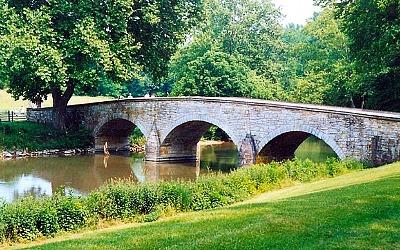Spring has landed early, and with the Civil War Sesquicentennial underway, now is the right time to tour our national military parks and battlefields. Summer brings hotter temperatures and bigger crowds.
Today at Guilford Courthouse National Military Park in Greensboro, North Carolina, many people will be exploring the trails and motor tour route during the park’s 231st anniversary weekend that includes events and reenactments of the March 1781 battle.
The Season is the Reason
Whether the battlefield is wooded, or the fields go on forever, the lack of vegetation after winter and the fresh breezes of spring are a great combination of conditions.
Chuck Cranfield, Guilford Courthouse superintendent, says, “Late winter and spring are a particularly good time to visit. The lack of leaves give you a much better feel for the lay of the land.” The park’s regular interpretive hikes start in mid-May.
The same could be said for wooded, mountainous King’s Mountain National Military Park, South Carolina, an autumn 1780 victory in the Southern Revolutionary campaign that was a precursor to the later pivotal battle at Guilford Courthouse.
Just because a battle took place at another time of year doesn’t mean spring isn’t a good time to visit. The Battle of Antietam near Sharpsburg, Maryland took place September 17th 1862, but Antietam National Battlefield is staging a variety of spring interpretive hikes, on Sunday March 25th, Saturday March 31st, and in April on the 8th, 14th, 22nd and 29th.
Antietam Park Ranger Keith Snyder, who leads many hikes, says the park offers a lot of interpretation during the September anniversary, but “one of the reasons we lead spring hikes is because it’s so easy to see the terrain features—and that is a big part of the story.”
“The only true way to understand a battle is to walk the battlefield,” Snyder says with convincing conviction. “That may not be as true now,” he says, “when war is fought in so many dimensions, in the air and cyberspace, too.”
In the Footsteps of History
“But for the Revolution, the Civil War, and later battles too,” Snyder says, “experiencing the lay of the land is critical. To achieve that, we walk in the very footsteps of the soldiers. That’s the most powerful, ultimate, battlefield experience to have. To be able to walk the fields and forests in the soldiers' footsteps, on the preserved ground of a national park—that experience is why these battlefields are so critical to our history.”
As the 150th anniversary nears, Snyder says, “The pressure is on, because we have such a dedicated group of repeat visitors and interpretive hikers that it’s very important that we do something different, really mix it up.” The park offers a variety of “overview” and “detail” hikes to do just that.
An example is the park’s Sunday April 29th “All Day Battlefield Hike” that happens in two parts. Hikers meet at 9:30 am to explore the Cornfield, West Woods and Sunken Road, then head to Auto Tour Stop # 9 at 1:30 pm to hear about the battle at the Lower Bridge and the final attack on the Confederate Line. The day ends around 4:30 pm with a total hike of about 5.5 miles.
Tour Road Tip
The plan for that hike actually highlights another strategy that visitors can use to tour battlefields at national military parks. Most of these parks have memorable auto tour routes that make it easy to scatter a few hikes or roadside forays all across the battlefield without having to hike too far.
Then again, why not take a lengthy walk and fully immerse in the stirring stories, often depicted on information-packed easels and displays? The budding vegetation, flowers, lime green early leaves, and cool weather not only offer great walking. Spring is a season of renewal and promise—a perfect time to ponder the struggles of those whose sacrifices are memorialized at all our national military parks and battlefields.
Check out these Antietam hikes—
Antietam has a nice line-up of spring walks. A March 25th hike looks at the role of Gen. George Greene’s division at Antietam. The walk occurs on the 150th anniversary of the naval battle between the USS Monitor and the CSS Merrimack. Greene’s son. Lt. Samuel Dana Greene, commanded the Monitor in the battle, six months before Antietam. The two-hour hike on March 31st features the role of artillery at Antietam.
Saturday April 14th, the two-mile interpretive walk explores the vicious fighting of French’s division that has made the Sunken Road such a symbol of the Civil War. At 1:30 Sunday April 22nd, the walk focuses on the fierce fighting near the Lower Bridge under Maj. Gen. Ambrose Burnside. Sunday April 29th, an “All Day Battlefield Hike” meets at 9:30 am, then again at Auto Tour Stop # 9 at 1:30 pm.




Add comment